Last updated: April 19, 2023
Article
Making Sense of Monitoring Data: Whitebark Pine Conditions in the Southern Cascades
Fall/Winter 2019 - Year after year, NPS scientists head out into the field to sample lake water, measure trees, and collect other kinds of data about park health. The rewards come when they can periodically step back and explore what they’ve learned.
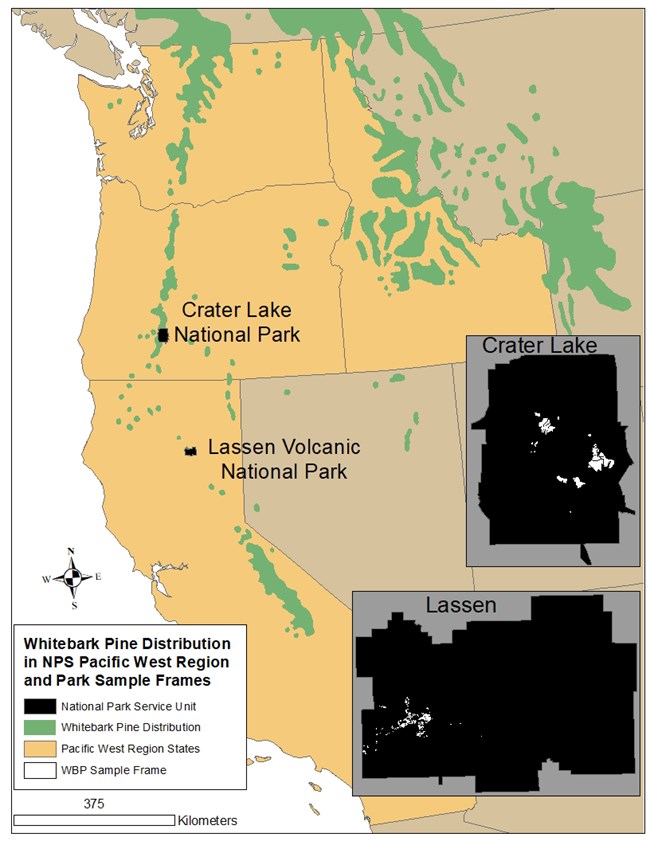
Klamath Network botanist, Sean Smith, has been monitoring whitebark pine (Pinus albicaulis) conditions in two network parks since 2012. Jenell Jackson, the graduate student he worked with early on, recently coauthored a paper with Smith and other scientists in the journal Forests sharing what they’ve learned about whitebark pine. Their study aims to support park managers grappling with how best to protect this increasingly threatened tree in the southern Cascades. Their paper is titled, “Whitebark Pine in Crater Lake and Lassen Volcanic National Parks: Assessment of Stand Structure and Condition in a Management and Conservation Perspective.”
Why do we care?
Whitebark pine trees are a keystone species of high elevation forests throughout the West (Figure 1). The nutritious seeds in their cones feed bears and other wildlife. Their branches provide shade that prolongs snowmelt and their roots stabilize the thin, rocky subalpine soil. But whitebark pine are in severe decline across their range. Multiple stressors include mountain pine beetle infestation, white pine blister rust infection, fire suppression, and climate change. With the Pacific Northwest projected to become warmer and drier, park managers in high elevation parks across the West face a complex problem in a potentially rapidly changing environment.
What questions did this paper ask and why?
The paper addressed two underlying questions relevant to park managers:
What is the current status of whitebark pine populations in Lassen Volcanic and Crater Lake National Parks? With the possibility of rapid change, knowing where these stressors are hitting hardest helps managers prioritize where to act.
How do these stressors interact with each other and possibly other environmental factors to influence the survival of whitebark pine trees? Managers need to understand how pests, pathogens, and possibly other factors, like climate or competition with other tree species, may interact to worsen or lessen damage to whitebark pine.
How did they collect the data?
For three years between 2012 and 2014, Smith and Jackson (lead author of the paper and also the field crew lead on this project in 2013-2014), collected data in thirty 50 × 50 m plots in each park. They recorded tree species, size, and health, as well as evidence of blister rust infection or pine beetle infestation. They then combined that information with external climate data to do the analyses. These three years of data were part of the Klamath Network’s ongoing long-term monitoring of whitebark pine as a vital sign related to each park’s health.
What did they learn?
- About half of the whitebark pine trees sampled in each park were infected with white pine blister rust (Figures 2, 3). This was somewhat surprising in Lassen Volcanic National Park, where little blister rust had been observed previously, and certainly alarming, as most trees infected with blister rust eventually die.
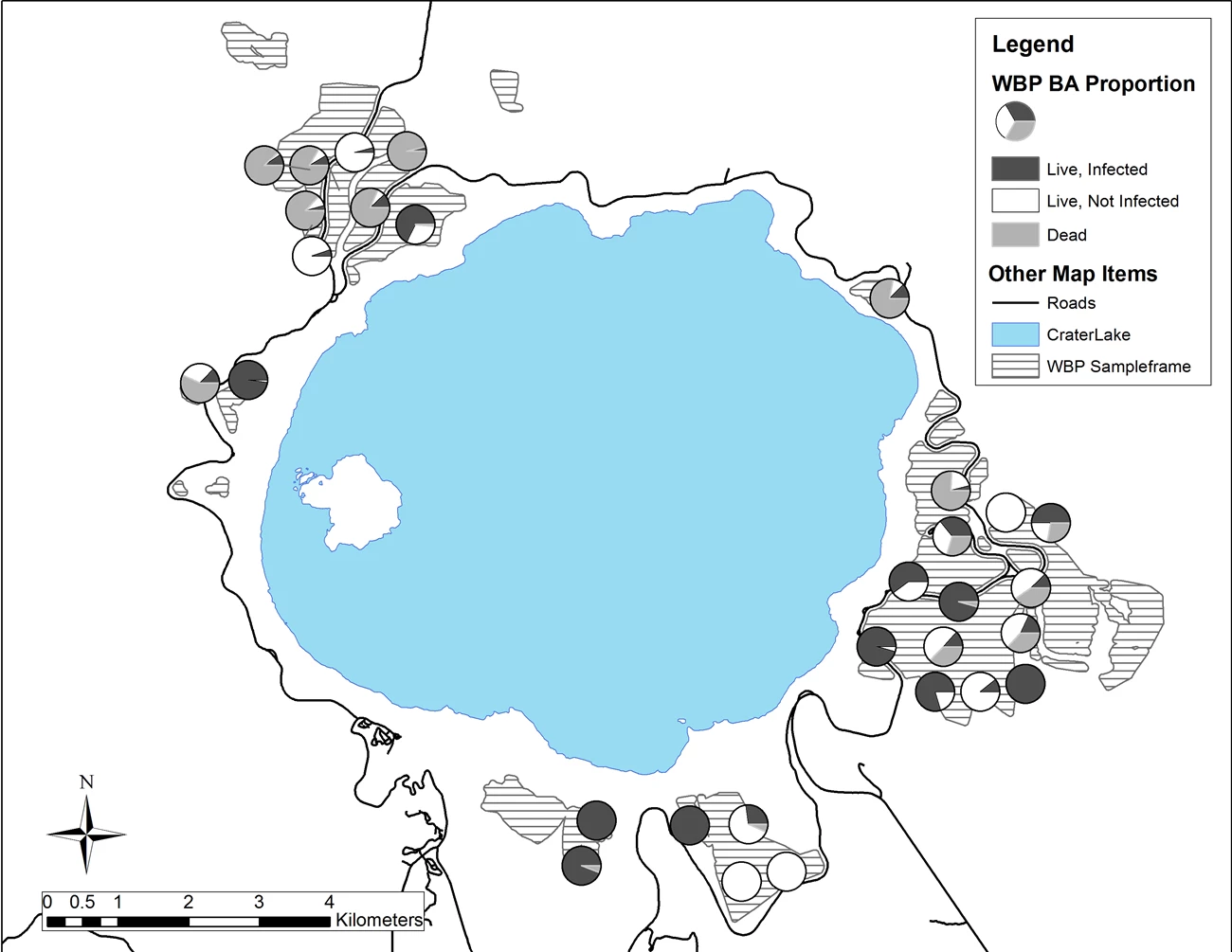
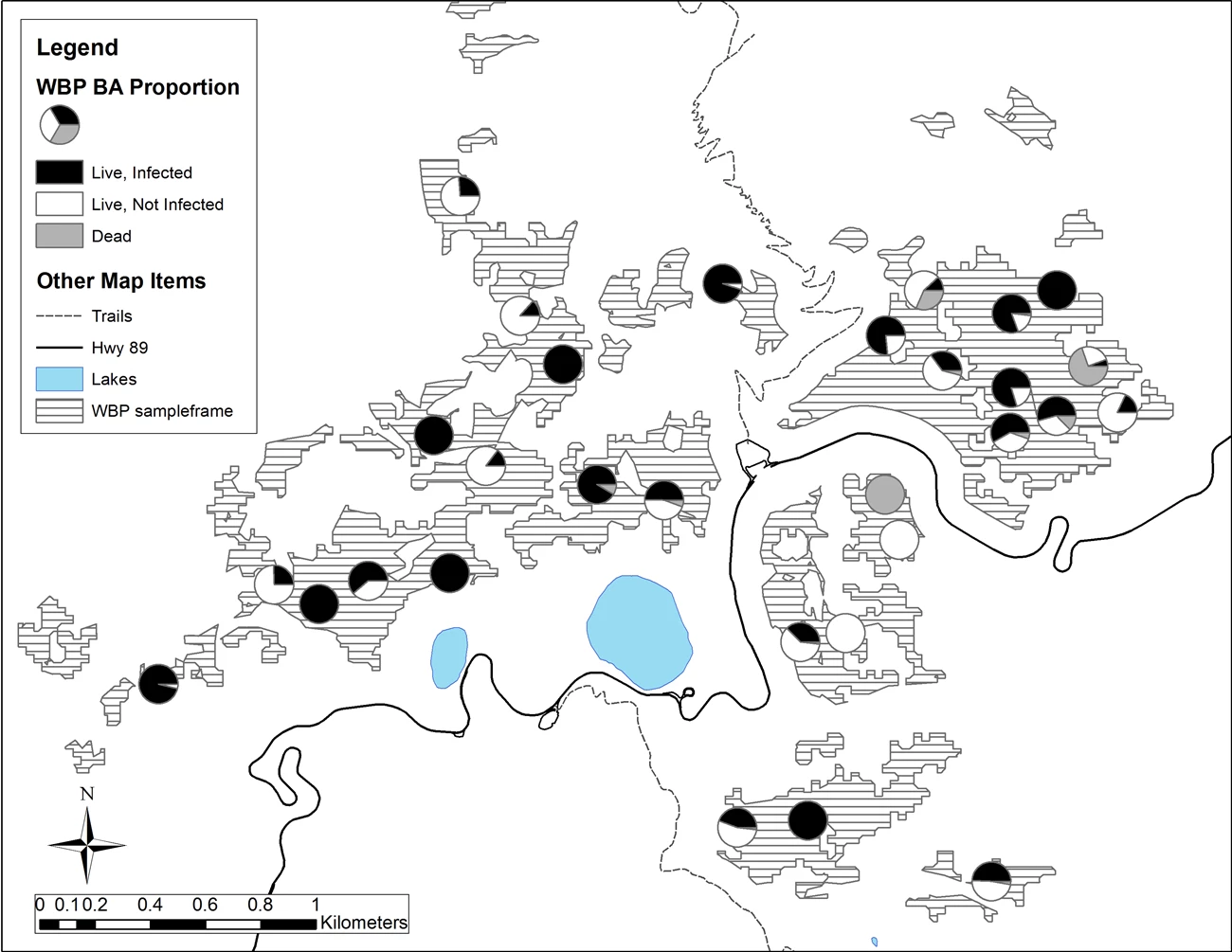
- In both parks, whitebark pine trees produced fewer cones when crowded by other tree species. Mountain hemlock (Tsuga mertensiana) was the main competitor, and this species seems to have expanded into the subalpine zone due to fire suppression or climatic changes, or both (Figure 4).
- In Crater Lake National Park, trees growing in drier areas experiencing water stress were more likely to be infected with blister rust and were less likely to have cones.
- In Crater Lake National Park, the combination of pest and pathogen seemed to make matters worse. Trees with blister rust were more likely to be attacked by mountain pine beetle.
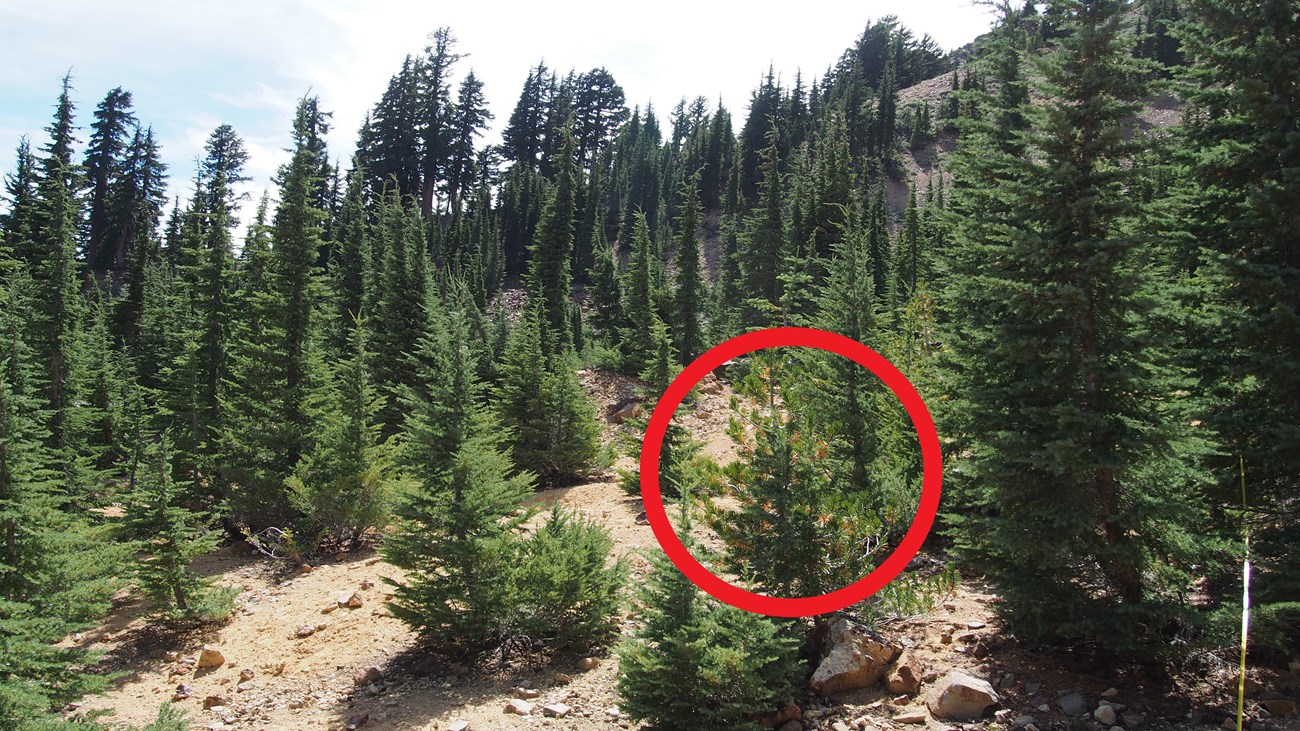
NPS / Sean Smith
How might park managers use this information?
Because of the serious threats whitebark pine populations face across the West, scientists have already identified range-wide conservation principles. Knowledge gained from this 3-year data set in southern Cascade national parks aligns with these principles, but has the added benefit of being tailored to parkspecific conditions.
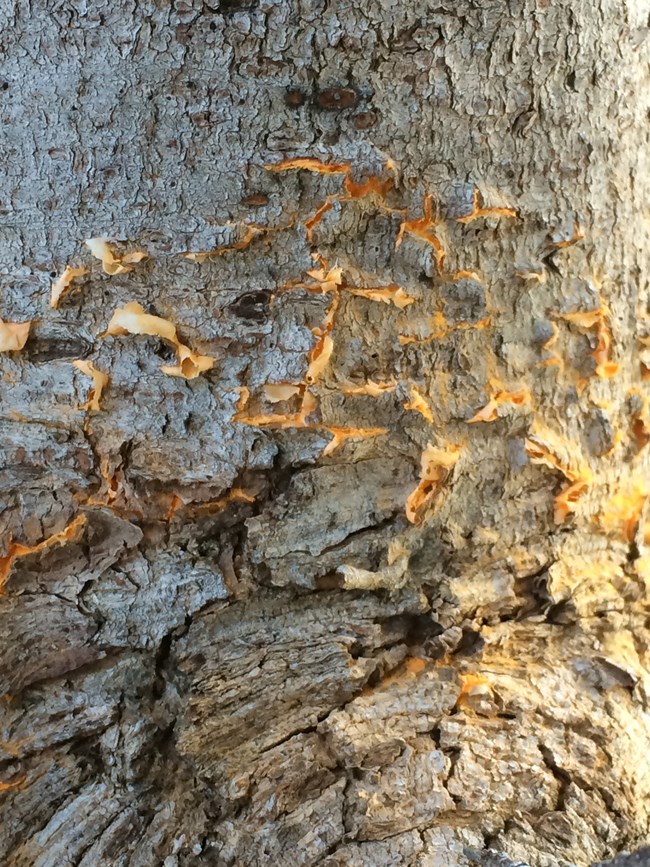
NPS / Sean Smith
1. Promote resistance to white pine blister rust
Other studies have shown that only an estimated 1% of whitebark pine trees are resistant to white pine blister rust. The high level of infection (~55%) of whitebark pine found by this study in both parks reveals how significant this stressor currently is and will be in the future. That’s because most trees don’t survive blister rust infection, especially when exacerbated by beetle infestation, drought, or competition from other species. Thus, the authors stressed the importance of promoting rust resistance as a conservation tool. One example (though not specifically mentioned in the paper) is ongoing genetic manipulation trials, such as those conducted at the Dorena Genetic Resources Center in Oregon, which aim to identify rust-resistant genotypes and propagate their seedlings for planting.
2. Conserve genetic diversity
The study’s finding that trees in drier (water-stressed) sites at Crater Lake National Park were associated with higher blister rust infection prompted the need for further research into this relationship. Were other factors involved? Should managers target wetter areas to plant whitebark pine seedlings? Is there potential value in finding and protecting whitebark pine genotypes that currently survive in drier, more southerly slopes just outside of the park?
3. Protect declining seed sources
The study recommended using verbenone at both Crater Lake and Lassen Volcanic National Parks to protect valuable cone producing whitebark pine. Verbenone mimics a pheromone made by mountain pine beetles to stave off beetle attack. Once a tree is infested, beetles release a pheromone to tell other beetles, “This tree is full – go find another tree!” Verbenone is not used currently at Lassen for two reasons. First, mountain pine beetle attack has been relatively sparse in Lassen compared with Crater Lake. Second, most whitebark pine stands at Lassen are in wilderness areas, which have more management restrictions. The study’s recommendation, however, is based on the potential for Lassen trees to eventually experience the same interactive effect between pest and pathogen as happened in Crater Lake. Because pine beetles were more likely to attack trees previously infected with blister rust at Crater Lake, the same pattern could occur in Lassen if and when mountain pine beetle populations expand at high elevations in the park.
4. Employ restoration treatments
Based on this study’s finding that competition from other tree species, especially mountain hemlock, lowered cone production in whitebark pines at Crater Lake, the authors promote addressing this stressor directly. Fire (natural managed or prescribed) and mechanical thinning are both restoration tools for reducing competition. The authors offer some discussion of the relative merits of each tool depending on the park, but overall conclude that reducing competition appears important to conserving this species over the long term in both parks.
Learn more
Read the published article to learn more details about differences between the two parks, additional knowledge gained, and a more comprehensive discussion of management implications: https://www.mdpi.com/1999-4907/10/10/834/htm. The lead author of this paper, Jenell Jackson, was supported by a cooperative agreement with Humboldt State University to collect the whitebark pine data as the crew lead for the Klamath Network. She analyzed the data for her master’s thesis, which then served as the basis for an NPS natural resource report publication, and finally, this journal article.
Article by Sonya Daw, Klamath Inventory and Monitoring Network
Adapted from The Klamath Kaleidoscope newsletter, Fall-Winter 2019 issue, by Jessica Weinberg McClosky
